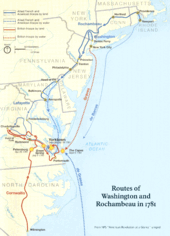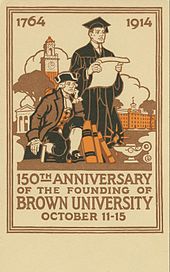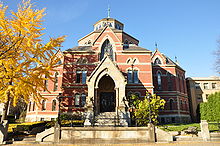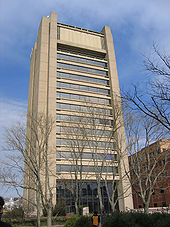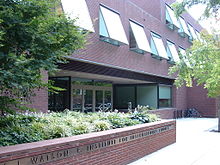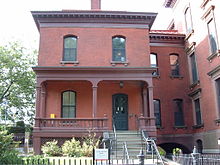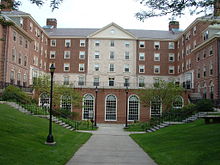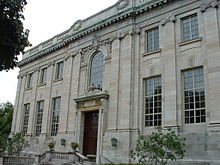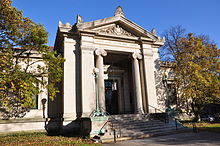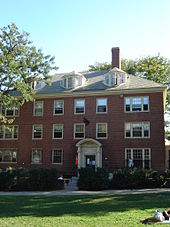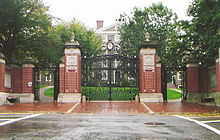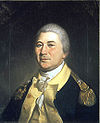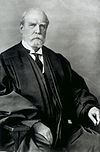- Brown University
-
Brown University 
The Brown University SealLatin: Universitas Brunensis Motto In Deo Speramus (Latin) Motto in English In God We Hope[1] Established 1764 Type Private Endowment US $2.5 Billion[2] Chancellor Thomas J. Tisch President Ruth J. Simmons Academic staff 682 full-time
[3]
200 Humanities
137 Bio/Medical
188 Physical Sciences
157 Social SciencesStudents 8,649[4] Undergraduates 6,316[4] Postgraduates 2,333 (410 medical)[4] Location  Providence, Rhode Island, United States
Providence, Rhode Island, United StatesCampus Urban
143 acres (579,000 m²)Colors Seal brown
Cardinal red
WhiteSports 37 varsity teams
Ivy League
NCAA Division IWebsite Brown.edu 
Brown University is a private, Ivy League university located in Providence, Rhode Island, United States. Founded in 1764 prior to American independence from the British Empire as the College in the English Colony of Rhode Island and Providence Plantations early in the reign of King George III (1760–1820), Brown is the third oldest institution of higher education in New England and seventh oldest in the United States.[5]
Brown was the first college in the nation to accept students regardless of religious affiliation.[6] Academically, Brown consists of The College, Graduate School, Alpert Medical School, and the School of Engineering. Brown's international programs are organized through the Watson Institute for International Studies. The New Curriculum, instituted in 1969, eliminated distribution requirements and allows any course to be taken on a satisfactory/no credit basis. In addition, there are no pluses or minuses in the letter grading system. The school has the oldest undergraduate engineering program in the Ivy League (1847). Pembroke College, Brown's women's college, merged with the university in 1971. While Brown is considered a small research university with 689 full-time faculty and 2,000 graduate students, five of its professors and two of its alumni have been honored as Nobel Laureates. The faculty added 100 new professors in the past 10 years under the Boldly Brown campaign.
Completed concentrations of undergraduates by area are Social Sciences (42%), Humanities (26%), Life Sciences (17%), and the Physical Sciences (14%).[7]
Brown's main campus is located on College Hill on the East Side of Providence. Several of the buildings on the Brown campus from its founding 18th century period through the 20th century offer fine representation of the Georgian style of American colonial era architecture.[8] The university's 37 varsity athletic teams are known as the Brown Bears. The school colors are seal brown, cardinal red, and white. Brown's mascot is the bear, which dates back to 1904.[9] The costumed mascot named "Bruno" frequently makes appearances at athletic games. People associated with the University are known as Brunonians.
Serving since 2001 as Brown's 18th president, Ruth J. Simmons is the first permanent female president of the university. She is also the first African American and second female president of an Ivy League institution, although she announced on September 15, 2011 that she will step down at the end of the fiscal year. President Simmons will remain as a Professor of Africana Studies and Comparative Literature.
Contents
History
Main article: History of Brown UniversityFounding of Brown
First Brown President and Delegate to the Congress of the Confederation James Manning. Detail from an oil painting by Cosmo Alexander, 1770; in University Hall, Brown University, Providence, R.I.
Brown owes its founding to the support of learning among a Baptist Church association but in 1762, the Baptist Minister Morgan Edwards was at first ridiculed for suggesting the founding of a college. In his Materials for a History of the Baptists in Rhode Island, Edwards wrote:"The first mover [Edwards, himself] for it [a Baptist college] in 1762 was laughed at as a projector of a thing impracticable. Nay, many of the Baptists themselves discouraged the design (prophesying evil to the churches in case it should take place) from an unhappy prejudice against learning."[10] Nonetheless, Edwards joined several others as an original fellow or trustee for the chartering of the College in the English Colony of Rhode Island and Providence Plantations (the former name for Brown University), the first Baptist college in the original thirteen colonies, and now one of the Ivy League universities.[11]
In 1763, The Reverend James Manning, a Baptist minister, and an alumnus of the College of New Jersey (predecessor to today's Princeton University), was sent to Rhode Island by the Philadelphia Association of Baptist Churches in order to found the college.[12] At the same time, local Congregationalists, led by future Yale College president Ezra Stiles, were working toward a similar end. The inaugural board meeting of the Corporation of the College in the English Colony of Rhode Island & Providence Plantations was held in the Old Colony House in Newport, Rhode Island. Former Royal Governors of Rhode Island under King George III Stephen Hopkins and Samuel Ward as well as the Reverend Isaac Backus and the Reverend Samuel Stillman were among those who played an instrumental role in Brown's foundation and later became American revolutionaries. On March 3, 1764, a charter was filed to create the College in Warren, Rhode Island, reflecting the work of both Stiles and Manning. The college gained its charter by grant of of King George III.
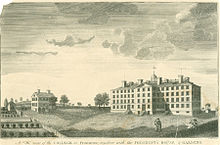 This copper-plate engraving from 1795 is the first known image of Brown. The original campus was a single academic building that was later named University Hall.
This copper-plate engraving from 1795 is the first known image of Brown. The original campus was a single academic building that was later named University Hall.
The charter had more than sixty signatories, including the brothers John, Nicholas and Moses of the Brown family, who would later inspire the College's modern name following a gift bestowed by Nicholas Brown, Jr. The college's mission, the charter stated, was to prepare students "for discharging the Offices of Life with usefulness & reputation" by providing instruction "in the Vernacular and Learned Languages, and in the liberal Arts and Sciences."[13] The charter required that the makeup of the board of 36 trustees include, 22 Baptists, five Friends, four Congregationalists, and five Church of England members, and by 12 Fellows, of whom eight, including the President, should be Baptists "and the rest indifferently of any or all denominations." It specified that "into this liberal and catholic institution shall never be admitted any religious tests, but on the contrary, all the members hereof shall forever enjoy full, free, absolute, and uninterrupted liberty of conscience." One of the Baptist founders, John Gano, had also been the founding minister of the First Baptist Church in the City of New York. The Encyclopædia Britannica Eleventh Edition remarks that "At the time it was framed the charter was considered extraordinarily liberal" and that "the government has always been largely non-sectarian in spirit."[14] In commemoration of this history, each spring faculty and the graduating class proceed down the hill, in academic dress, to the grounds of the First Baptist Meeting House (erected in 1774, "for the publick Worship of Almighty GOD and also for holding Commencement in") for the conferral of the bachelors degree.[15]
James Manning was sworn in as the College's first president in 1765. His tenure lasted until 1791. During his presidency, the College moved to its present location on College Hill in the East Side of Providence in 1770 and construction of the first building, the College Edifice, began. This building was renamed University Hall in 1823.The Brown family — Nicholas Sr., John, Joseph, and Moses,— were instrumental in the move to Providence, funding and organizing much of the construction of the new buildings on the former Rev. Chad Brown farm. The family's connection with the college was strong: Joseph Brown became a professor of Physics at the University, and John Brown served as treasurer from 1775 to 1796. In 1804, a year after John Brown's death, the University was renamed Brown University in honor of John's nephew, Nicholas Brown, Jr., who was a member of the class of 1786 and in 1804 contributed $5,000 toward an endowed professorship. In 1904, the John Carter Brown Library was opened as a research center on Americas based on the libraries of John Carter Brown and his son John Nicholas Brown. The Brown family was involved in various business ventures in Rhode Island, and made a small part of its wealth in businesses related to the slave trade. The family itself was divided on the issue. John Brown had unapologetically defended slavery, while Moses Brown and Nicholas Brown Jr. were fervent abolitionists. In recognition of this complex history, under President Ruth Simmons, the University established the University Steering Committee on Slavery and Justice in 2003.[16]
Brown began to admit women when it established a Women's College in Brown University in 1891, which was later named Pembroke College in Brown University. "The College" (the undergraduate school) merged with Pembroke College in 1971 and became co-educational.
The language of the Brown University charter has long been interpreted by the university as discouraging the founding of a business school or law school. Brown continues to be one of only two Ivy League colleges with neither a business school nor a law school (the other being Princeton).
American Revolution
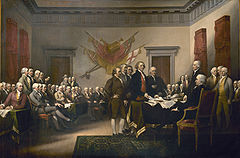 John Trumbull's Declaration of Independence. The signers included Brown's first chancellor Stephen Hopkins. Hopkins wears a hat and stands in the back of the room near the door on the left.
John Trumbull's Declaration of Independence. The signers included Brown's first chancellor Stephen Hopkins. Hopkins wears a hat and stands in the back of the room near the door on the left.
Stephen Hopkins, Chief Justice and Governor of the English Colony of Rhode Island and Providence Plantations, was a Delegate to the Colonial Congress in Albany in 1754 and to the Continental Congress from 1774 to 1776. He was a signatory to the United States Declaration of Independence on behalf of the state of Rhode Island. He also served as the first chancellor of Brown from 1764 to 1785. His house is a minor historical site, located just off the main green at Brown.
In 1781, allied American and French armies under the command of General George Washington and the Comte de Rochambeau, who led troops sent by King Louis XVI of France, embarked on a 600-mile (970 km) march from Rhode Island to Virginia, where they fought and defeated British forces sent by King George III of the United Kingdom on the Yorktown, Virginia peninsula. The victory ended the major battles of the American Revolutionary War. Prior to the march, Brown University served as an encampment site for French troops, and the College Edifice, now University Hall, was turned into a military hospital.[17]
Other founders of Brown who played significant roles in the American revolutionary effort included John Brown in the Gaspee Affair, Chief Justice Dr. Joshua Babcock as major general in the state militia and William Ellery as a signatory to the Declaration of Independence.
James Mitchell Varnum, who graduated with honors in Brown's first graduating class of 1769, served as one of General George Washington's Continental Army Brigadier Generals and later as Major General in command of the entire Rhode Island militia.[18] David Howell, who graduated with an A.M. in the same year as General Varnum, served as a delegate to the Continental Congress from 1782 to 1785.
In 1786, President James Manning was elected and served as representative for Rhode Island to the seventh session of the United States in Congress Assembled, held in New York. In that capacity, he served on the Grand Committee, which proposed fundamental amendments to the Articles of Confederation and presaged the Constitution of the United States.[19]
New curriculum
In 1850, Brown President Francis Wayland wrote: "The various courses should be so arranged that, insofar as practicable, every student might study what he chose, all that he chose, and nothing but what he chose."[20] In 1969, the adoption of the New Curriculum marked a milestone in the University's institutional history and is seen as a significant step towards realizing Wayland's vision. The curriculum was the result of a paper written by Ira Magaziner and Elliot Maxwell entitled "Draft of a Working Paper for Education at Brown University."[21] The paper came out of a year-long Group Independent Study Project (GISP) involving 80 students and 15 professors. The group was inspired by student-initiated experimental schools, especially San Francisco State College, and sought ways to improve education for students at Brown. The philosophy they formed sought to "put students at the center of their education" and to "teach students how to think rather than just teaching facts."[22]
The paper made a number of suggestions for improving education at Brown, including a new kind of interdisciplinary freshman course that would introduce new modes of inquiry and bring faculty from different fields together. Their goal was to transform the survey course, which traditionally sought to cover a large amount of basic material, into specialized courses that would introduce the important modes of inquiry used in different disciplines.[23]
Following a student rally in support of reform, President Ray Heffner appointed the Special Committee on Curricular Philosophy with the task of developing specific reforms. These reforms, known as the Maeder Report (after the chair of the committee), were then brought to the faculty for a vote. On May 7, 1969, following a marathon meeting with 260 faculty members present, the New Curriculum was passed. Its key features included the following:[22]
- Modes of Thought courses aimed at first-year students
- Interdisciplinary University courses
- Students could elect to take any course Satisfactory/No Credit
- Distribution requirements were dropped
- The University simplified grades to ABC/No Credit, eliminating pluses, minuses and D's. Furthermore, "No Credit" would not appear on external transcripts.
Except for the Modes of Thought courses, a key component of the reforms which have been discontinued, these elements of the New Curriculum are still in place.
Additionally, due to the school's proximity and close partnership with the Rhode Island School of Design (RISD), Brown students have the opportunity to take up to four courses at RISD and have the credit count towards a Brown degree. Likewise, RISD students can also take courses at Brown. Since the two campuses are effectively adjacent to each other, the two institutions often partner to provide both student bodies with services (such as the local Brown/RISD after-hours and downtown transportation shuttles).[24][25] In July 2007 the two institutions announced the formation of the Brown/RISD Dual Degree Program, which allowed students to pursue an A.B. degree at Brown and a B.F.A. degree at RISD simultaneously, a five-year program. The first students in the new program matriculated in 2008.[26]
As recently as 2006, there has been some debate on reintroducing plus/minus grading to the curriculum. Advocates argue that adding pluses and minuses would reduce grade inflation and allow professors to give more specific grades,[27] while critics say that this plan would have no effect on grade inflation while increasing unnecessary competition among students and violating the principle of the New Curriculum.[28] Ultimately, the addition of pluses and minuses to the grading system was voted down by the College Curriculum Council.[29]
The University is currently in the process of broadening and expanding its curricular offerings as part of the "Plan for Academic Enrichment." The number of faculty has been greatly expanded. Seminars aimed at freshmen have begun to be offered widely by most departments.[30]
As a part of the re-accreditation process, Brown University is undergoing an expansive reevaluation of its undergraduate education offerings through the newly appointed Task Force on Undergraduate Education. This Task Force is charged with assessing the areas of general education, concentrations, advising, and pedagogy and assessment.[31]
Presidents of Brown University
Main article: Presidents of Brown UniversityThe current president of the University is Ruth J. Simmons. She is the 18th president of Brown University and first African American president of an Ivy League institution. According to a November 2007 poll by The Brown Daily Herald, Simmons enjoys a more than 80% approval rating among Brown undergraduates.[32] On September 15, 2011, Simmons announced her plans to step down as president at the end of her term in June 2012. She has plans to remain at Brown as a professor of Comparative Literature and Africana Studies.[33]
Academics
The College
Founded in 1764, The College is the oldest school of Brown University. Nearly 6,000 undergraduate students are currently enrolled in the college, and approximately 80 concentrations (majors) are offered. Completed concentrations of undergraduates by area are Social Sciences (42%), Humanities (26%), Life Sciences (17%), and the Physical Sciences (14%).[7] The concentrations with the greatest number of students are Biology, History, and International Relations.[34] Brown is one of the few schools in the United States with an undergraduate concentration (major) in Egyptology. Undergraduates can also design an independent concentration if the existing standard programs do not fit their interests.
35% of undergraduates pursue graduate or professional study immediately, 60% within 5 years, and 80% within 10 years.[35] For the Class of 1998, 75% of all graduates enrolled in a graduate or professional degree program since graduating from Brown.[36] The most degrees acquired were a Master's (35%) in any field, a Medical (28%), Doctoral (22%), or a Law (14%) degree, in highest order.[36] There are not many who pursued the Ph.D compared to a Master's (for instance, business), or a Medical degree.
The highest fields of employment for graduates of the College are Business (36%), K-12 Education (19%), Health/Medical (6%), Arts (6%), Government (6%), and Communications/Media (5%) in highest order.[36]
Graduate School
Main article: Brown University Graduate SchoolEstablished in 1887, The Graduate School currently houses over 1,700 students studying over 50 disciplines. Eight different master's degrees are offered as well as Ph.D. degrees in over 40 subjects ranging from Applied Mathematics to Public Policy.
Alpert Medical School
The University's medical program started in 1811, but the school was suspended by President Wayland in 1827 after the program's faculty declined to live on campus (a new requirement under Wayland). In 1975, the first M.D. degrees from the new Program in Medicine were awarded to a graduating class of 58 students. In 1991, the school was officially renamed the Brown University School of Medicine, then renamed once more to Brown Medical School in October 2000.[37] In January 2007, self-made entrepreneur Warren Alpert donated $100 million to Brown Medical School on behalf of the Warren Alpert Foundation, tying Sidney Frank for the largest single monetary contribution ever made to the University. In recognition of the gift, the faculty of Brown University approved changing the name of the Brown Medical School to The Warren Alpert Medical School of Brown University. It is currently ranked 29th among U.S. medical schools in research and 28th in primary care according to US News and World Report.[38] Admissions to Alpert is one of the most competitive in the nation, with only less than 2% of those applying through the Standard Route accepted in 2008 (5,902 applications for 94 spots).
The medical school is known for its eight-year Program in Liberal Medical Education (PLME), which was started in 1984 and is one of the most selective programs in the nation. Each year, approximately 60 high school students matriculate into the PLME out of an applicant pool of about 1,600. Since 1976, the Early Identification Program (EIP) has encouraged Rhode Island residents to pursue careers in medicine by recruiting sophomores from Providence College, Rhode Island College, the University of Rhode Island, and Tougaloo College. In 2004, the school once again began to accept applications from premedical students at other colleges and universities via AMCAS like most other medical schools. The medical school also offers combined degree programs leading to the M.D./Ph.D., M.D./M.P.H. and M.D./M.P.P. degrees.
School of Engineering
Main article: Brown University School of EngineeringBrown has the oldest engineering program in the Ivy League. In 1916, multiple Departments of Engineering were consolidated into the Division of Engineering. In 2010, the Division of Engineering was reclassified as the School of Engineering.
Research centers and institutes
Marine Biological Laboratory
The Marine Biological Laboratory (MBL) is an independent research institution established in 1882 at Woods Hole, Massachusetts. The laboratory is linked to 54 current or past Nobel Laureates at its research or teaching faculty. Since 2005, the MBL and Brown University have collaborated in a Ph.D.-awarding Graduate Program in Biological and Environmental Sciences, which brings together faculty from both institutions. In 2010, the joint program was extended to include more professors participating in the partnership. The current faculty includes those from the Ecosystems Center, the Bay Paul Center, the Program in Cellular Dynamics, and the Marine Resources Center.
Watson Institute for International Studies
The Watson Institute for International Studies, usually referred to as the Watson Institute, is a center for the analysis of international issues at Brown University. Its original benefactor was Thomas J. Watson, Jr., former Ambassador to the Soviet Union and president of IBM.
Pembroke Center for Teaching and Research on Women
Main article: Pembroke Center for Teaching and Research on WomenThe Pembroke Center for Teaching and Research on Women, was established at Brown in 1981 as a research center on gender. It was named in honor of Pembroke College (Brown University), a decade after its merger with Brown University, and to recognize the history of women's efforts to gain access to higher education. Along with its numerous academic programs, including its sponsorship of post-doctoral research fellowships, the undergraduate concentration in Gender and Sexuality Studies, and the annual Pembroke Seminar, the Pembroke Center also organizes a number of programs throughout the year to recognize the historical achievements of women. Leading historian and social scientist Joan Wallach Scott was founding director of the Center. The Pembroke Center is affiliated with the Sarah Doyle Women's Center.
Computing
Several projects of note involving hypertext and other forms of electronic text have been developed at Brown, including FRESS, Brown University Interactive Language (BRUIN), Hypertext Editing System, and Women Writers Project. In addition, the Computer Science department at Brown is home to The CAVE. This project is a complete virtual reality room, one of few in the world, and is used for everything from three-dimensional drawing classes to tours of the circulatory system for medical students. In 2000, a group of students from the university's Technology House converted the south side of the Sciences Library into a giant video display which allowed bystanders to play Tetris, the largest of its kind ever in the Western Hemisphere. Constructed from 11 custom-built circuit boards, a 12-story data network, a personal computer running Linux, a radio-frequency video game controller, and over 10,000 Christmas lights, the project was named La Bastille and could be seen for several miles.[39][40]
Profile
Rankings
University rankings (overall) National Forbes[41] 45 U.S. News & World Report[42] 15 Washington Monthly[43] 63 Global ARWU[44] 65 QS[45] 39 Times[46] 55 U.S. News & World Report ranked Brown 15th among national universities in its 2011 edition (published in August 2010). Undergraduates make up a larger proportion of the student body at Brown than at any of the other Ivy League universities, leading some Brown administrators to question the fairness of the ranking in light of the University's focus on undergraduate education.[47] The same edition also ranked Brown 6th among national universities for undergraduate teaching,[48] and 6th in a high school guidance counselor ranking of which universities "offer the best education to their students."[49] Internationally, in 2010 Brown ranked 55th in the Times Higher Education World University Rankings and the Academic Ranking of World Universities ranked Brown 65th. In 2011 QS World University Rankings places Brown at 39th.[50][51] According to the 2005 paper Academic Ranking of World Universities - Methodologies and Problems by the rankers, Brown's PCP (performance per-capita) score is equal to that of Columbia University, at 32.1.[52]
Brown ranked 7th in the country (between Princeton and Columbia) in a study of high school seniors' revealed preferences for matriculation conducted by economists at Harvard, Wharton, and Boston University, and published in 2005 by the National Bureau of Economic Research.[53] The 2008 Center for College Affordability and Productivity (CCAP) ranked Brown 5th in the country among national universities."[54]
As it had in 2007 and 2010, the 2011 Princeton Review email poll of college students ranked Brown 1st in the country for "Happiest Students."[55] Brown is 3rd in the country (tied with Stanford) in the number of students awarded Fulbright grants, according to the October 2010 ranking compiled by the Chronicle of Higher Education.[56]
Graduate programs that ranked the top 10 in the 2010 US News and World Report graduate school rankings included applied mathematics at 5th [57] and growth economics at 8th.[58] Those that are ranked in the top 20 are history at 14th,[59] economics at 17th,[60] English at 13th,[61] engineering at 20th, mathematics at 14th,[62] and computer science at 20th.[62]
Admission and financial aid
Brown is one of the most selective universities in the world. The admission rate for the undergraduate class of 2015 was 8.7 percent. [63] For the class of 2014, 96 percent of accepted students were in the top 10 percent of their high school class, and 38 percent were either valedictorian or salutatorian.[64] Brown began using the Common Application in the Fall of 2008. The Graduate School is also highly competitive, with graduate programs accepting 18% of the 7,283 students who applied in 2008. The Warren Alpert Medical School of Brown University accepted less than 2% of more than 5,000 applicants.[65][66][67][68]
Brown has recently adopted a financial aid policy which eliminates loans for all students whose family incomes are under $100,000. Furthermore, Brown has also eliminated all parental contributions for families whose incomes fall under $60,000.[69] For these purposes, income is calculated by summing the adjusted gross income plus all untaxed income. The program allocates approximately $70 million toward financial aid.
Brown seeks diverse applicants from "all walks of life, backgrounds, interests, and cultural heritages" but has "no quotas of any kind".[70]
Campus
Brown is the largest institutional landowner in Providence,[71] with properties in the East Side and the Jewelry District.[72] Unlike some other schools, there are also no clear physical landmarks to determine where Brown's campus begins or ends.[71]
There is no official designation of different campus areas from the University, but the institution's buildings can be roughly categorized as follows.
Main campus
Brown's main campus is located atop College Hill, in the East Side, across the Providence River from downtown Providence. This is the where the University was relocated in 1770 after it was first established in Warren, Rhode Island, in 1764. The main campus consists of 235 buildings and covers 143 acres (0.58 km2). A salient feature of Brown's campus is that many of the academic departments reside in smaller, Victorian-era houses that the University has acquired over the years from the surrounding neighborhood.
The main campus area can be subdivided further into the inner, traditional campus greens and the outer neighborhood. The two greens, the Main Green and Lincoln Field, are large grass fields perpendicular to each other. These two areas contain many of the larger and more traditional academic and dormitory buildings, including University Hall (1770). This part of the main campus is enclosed by brick and rod iron fence, with the Van Wickle Gates serving as the prominent entrance on College Street. It is this area that is featured in most publications and photographs of Brown's campus.
Outside of the gates, but still considered part of the main campus, are other University buildings and libraries that have been built at Brown over the centuries. This includes the Wriston Quad to the south of the Main Green; the John Hay Library and John D. Rockefeller, Jr. Library directly across the street from the Van Wickle Gates; and the Sciences Library and Thomas J. Watson, Sr. Center for Information Technology (CIT) adjacent to the Soldiers Memorial Gate. Because this area is not confined by the gates, Brown has been able to acquire larger plots of land and construct much larger buildings as the University has expanded.
Adjacent to Brown's main campus, and further down the Hill to the west by the Providence River, is the campus of the Rhode Island School of Design. Thayer Street, which runs through Brown's campus, is a commercial district that hosts many restaurants and shops popular with students and faculty from Brown and RISD.
Pembroke Campus
When Pembroke College merged with Brown in 1971, the campus was absorbed as part of Brown's overall campus. For the most part, the campus is made up of dormitories, although notable exceptions include: Alumnae Hall, which houses a dance floor and a small University run diner known as The Gate; Smith-Buonano hall, the gymnasium of Pembroke College that was later renovated to contain many classrooms; and Pembroke Hall, the original classroom building for Pembroke College and now home to the Cogut Center for the Humanities and the Pembroke Center for Teaching and Research on Women. Furthermore, the campus has its own dining hall, Verney-Woolley Dining Hall, the second of Brown's main dining halls. Somewhere between 25 and 30% of the incoming Freshman class lives on Pembroke, though there are also many upperclassmen. The Brown Walk connects Pembroke Campus to the main campus.
East Campus
The East Campus was originally the main campus location of Brown's former neighbor Bryant College. Brown purchased Bryant's East Side campus in 1969 for $5.0 million when the latter school was moving to a new location. This added 10 acres (40,000 m2) of land and additional 26 buildings adjacent to the main campus area. The area was officially designated East Campus in 1971.
Other areas
Also on the Hill, but further to the south and away from the main campus area, is Wickenden Street, another commercial district offering restaurants and shops. Brown Stadium, built in 1925 and home to the football team, is located approximately a mile to the northeast of the main campus. More recently, Brown has expanded into the Jewelry District, located in southern downtown Providence, by acquiring and renovating five buildings to serve as administrative and research facilities. Outside of Providence, Brown also owns a 376-acre (1.52 km2) property, the Mount Hope Grant, in Bristol, which is the setting of the Haffenreffer Museum of Anthropology. Just south of Pembroke Campus and next to the Brown Bookstore, the Granoff Center for the Creative Arts opened in January, 2011.
John Hay Library
The John Hay Library is the second oldest library on campus. It was named for John Hay (class of 1858, private secretary to Abraham Lincoln and Secretary of State under two Presidents) at the request of his friend Andrew Carnegie, who contributed half of the $300,000 cost of the building.[73] Constructed with Vermont white marble in an English Renaissance style, the library was dedicated on November 10, 1910 and had an estimated collection of 300,000 volumes.[74] It is now the repository of Brown University archives, rare books and manuscripts, and special collections. Noteworthy among the latter are the Anne S. K. Brown Military Collection[75] (described as "the foremost American collection of material devoted to the history and iconography of soldiers and soldiering"), the Harris Collection of American Poetry and Plays (described as "the largest and most comprehensive collection of its kind in any research library"), the Lownes Collection of the History of Science (described as "one of the three most important private collections of books of science in America"), and (for popularity of requests) the papers of H.P. Lovecraft. The Hay Library is home to one of the broadest collections of incunabula (15th-century printed books) in the Americas, as well as such rarities as the manuscript of Orwell's Nineteen Eighty-Four and a Shakespeare First Folio. There are also three books bound in human skin.[76]
The Pembroke Center for Teaching and Research on Women manages the Elizabeth Weed Feminist Theory Papers and the Christine Dunlap Farnham Archives, both rich resources for feminist scholars.
John Carter Brown Library
The John Carter Brown Library, founded in 1846, is administered separately from the University, but has been located on the Main Green of the campus since 1904. It is generally regarded as the world's leading collection of primary historical sources pertaining to the Americas before 1825. It houses a very large percentage of the titles published before that date about the discovery, settlement, history, and natural history of the New World. The "JCB", as it is known, publishes Bibliotheca Americana, the main bibliography in the field. Typical of its noteworthy holdings is the best preserved of the seven surviving copies of Bay Psalm Book, the first extant book printed in British North America. There is also a very fine Shakespeare First Folio, added to the collection by John Carter Brown's widow (a Shakespeare enthusiast) on the grounds that it includes The Tempest, a play set in the New World. The JCB holdings comprise more than 50,000 early titles and about 16,000 modern books, as well as prints, manuscripts, maps, and other items in the library's specialty. The JCB occupies a Beaux-Arts style building designed by Shepley, Rutan, and Coolidge. The 1904 edifice was expanded in 1990 by architects Hartman-Cox of Washington, D.C.
Sustainability
Brown University has committed to "minimize its energy use, reduce negative environmental impacts and promote environmental stewardship."[77] The Energy and Environmental Advisory Committee has developed a set of ambitious goals for the university to reduce its carbon emissions and eventually achieve carbon neutrality. The Brown is Green website collects information about Brown's progress toward greenhouse gas emissions reductions and related campus initiatives like courses, research, projects and student groups.[78] Brown received an A- on the 2009 College Sustainability Report Card, developed by the Sustainable Endowments Institute. Brown was one of only 15 schools to receive a grade above a B+. There were no schools in the report that received an "A".[79] Brown has a number of active environmental leadership groups on campus, including, most notably, emPower and ecoReps.[80] These groups have begun a number of campus-wide environmental initiatives—including the creation of a task force to eliminate the supply and demand of bottled water and investigating a composting program.
Boldly Brown
Under President Ruth Simmons, the University has launched Boldly Brown: The Campaign for Academic Enrichment. This campaign consists of re-evaluating the existing curriculum and raising money for greater academic ambition. The money will be used for academic programs, research, new facilities, biology and medicine, students who need financial assistance, and expanding the faculty and staff. In June 2009, it was announced that the campaign had met its goal 19 months ahead of target, with record levels of giving despite the global economic crises of the fiscal year. The total sum raised currently stands at over US$1.5 billion.[81]
Student life
Atmosphere
Brown University has recently been ranked #1 for America's Happiest College Students, according to the Princeton Review 2010 rankings.[82] Brown was also named "the most fashionable school in the Ivy League" by the fashion trade journal Women's Wear Daily on the basis that students on campus seem to have the strongest sense of personal style.[83]
Brown is home to an active on-campus nightlife.[citation needed] An array of parties takes place on weekends, most of them in dorms and off-campus houses.[citation needed]
Athletics
Brown is a member of the National Collegiate Athletic Association (NCAA) Division I Ivy League athletic conference. It sponsors 37 varsity intercollegiate teams. Its athletic programs have been featured in the College Sports Honor Roll as one of the top 20 athletic programs in the country according to U.S. News & World Report. Brown Women's Rowing Team has won 6 national titles in the last 12 years, the Men's Rowing Team perennially finishes in the top 5 in the nation and swept the Eastern Sprints in 2009. Brown Football's reemergence, and its surge in northeast college popularity generally, is credited to its historic 1976 Ivy League championship team, which was Brown's first Ivy League Football Champions. The 1976 "Magnificent Andersons," so named for its coach, John Anderson, was 8-1, tying it with Yale, which the 1976 Brown team defeated head to head that year, and included an ABC Sports televised football game, defeating Harvard 16-14. Since the 1976 football championship season, Brown Football has won three Ivy League championships under the most successful coach in its history, Phil Estes: 1999, 2005, and 2008. Brown's Men's Soccer program is consistently ranked in the top 25 and has won 18 Ivy League titles overall, including 8 of the last 12. Recent graduates play professionally in Major League Soccer and overseas. The Men's Lacrosse team also has a long and storied history, and more recently the program has again attained national rankings and exposure. In 2007, Brown won its first Ivy League baseball championship in school history. Brown's Varsity Equestrian team won the Ivy League Championships for the past two years in a row, and has consistently performed extremely well within the team's zone and region.[84] Brown also features several competitive intercollegiate club sports, including its nationally ranked Sailing, Ultimate, and Women's Rugby teams. In 2005, the Men's Club Ultimate Frisbee team, Brownian Motion, won the National Championships.
Student organizations
See also: Category:Brown University organizationsThere are over 300 registered student organizations on campus with diverse interests. The Student Activities Fair, during the orientation program, provides first-year students the opportunity to become acquainted with the wide range of organizations.
Publications
- The Brown Daily Herald
- College Hill Independent
- Critical Review
- Brown Journal of World Affairs
- Brown Journal of History
- Brown Policy Review
- The Brown Spectator
- The Brown Contemporary
- The Brown Noser
- The Brown Jug
- Clerestory, Journal of the Arts
- Issues Magazine
- Watershed: Brown/RISD Journal of Environment and Culture
- VISIONS
- Science and Society Review (affiliated with the Brown chapter of The Triple Helix)
- Catalyst Magazine
Fine arts
- Brown University Band
- Brown University Orchestra
- Brown Opera Productions
- Production Workshop
Social Justice
- Space in Prisons for Arts and Creative Expression
- Students for a Democratic Society
- Students for Sensible Drug Policy
- Brown Immigrant Rights Coalition
- Brown Student Labor Alliance
Others
- Brown Debating Union
- Brown Television
- WBRU
- Undergraduate Council of Students
- Undergraduate Finance Board
- Brown University Mock Trial
- BSR
- Brown Badmaash Dance Company
- The Brown Derbies
- The Chattertocks of Brown University
- Graduate Student Council[85]
- Starla and Sons
- Ivy Film Festival
Residential and Greek Societies
12.7% of Brown students are in fraternities or sororities. There are 10 residential Greek houses: six all-male fraternities (Alpha Epsilon Pi, Delta Tau, Delta Phi, Theta Delta Chi, Sigma Chi, and Phi Kappa Psi), two sororities (Alpha Chi Omega and Kappa Alpha Theta), one co-ed fraternity (Zeta Delta Xi), and one co-ed literary society (Alpha Delta Phi). All recognized Greek letter organizations live on-campus in University-owned dorm housing. All ten Greek houses are overseen by the Greek Council and are located on Wriston Quadrangle.
An alternative to fraternity life at Brown are the program houses, which are organized around various themes. As with Greek houses, the existing residents of each house take applications from students, usually at the start of the Spring semester. Examples of program houses include: St. Anthony Hall (located in King House), Buxton International House, the Machado French/Hispanic House, Art House, Technology House, Harambee (African culture) House, Culinary Arts (Cooking) House and Interfaith House.
Currently, there are three student cooperative houses at Brown. Two of the houses, Watermyn and Finlandia on Waterman Street, are owned by the Brown Association for Cooperative Housing (BACH), an independent non-profit corporation owned and operated by house members.
The third co-op, West House, is located in a Brown-owned house on Brown Street. All three houses also run a vegetarian food co-op for residents and non-residents.
Secret societies
Secret societies at Brown originated as literary clubs in the mid-18th century, and primarily existed to organize debates among their members. One early literary club was the Pronouncing Society, which disbanded in the mid-1770s.[86] Another was Athenian at Queen's, founded in 1776 but also dissolved shortly afterwards.[87] The Philermenian Society (founded as the Misokosmian Society) arose in 1794.[88] In reaction to the Federalist Philermenians, a Democratic-Republican club called the United Brothers Society organized in 1806.[89] In 1824 a third group, the Franklin Society, was formally recognized by the university president, and counted as honorary members Thomas Jefferson, John Quincy Adams, and Henry Clay.[90] However, by the Civil War, most of these organizations had dissipated on account of newer Greek letter fraternities.[91] There remains some dispute over the presence of these groups today, and at least one student organization, Pacifica House, claims descent from early secret societies.[92][93] The Undergraduate Council of Students, Brown's student government, also reflects this historical legacy. The UCS originated as the Cammarian Club in 1893, a semi-secret senior society that served as an intermediary between the student body and the administration, and which ritualistically "tapped" 15 new men each year until its dissolution after World War II.[94]
Traditions
Though the early history of Brown as a men's school includes a number of unusual hazing traditions, the University's present-day traditions tend to be non-violent while maintaining the spirit of zaniness.[95]
Van Wickle Gates
The Van Wickle Gates, dedicated on June 18, 1901, have a pair of center gates and a smaller gate on each side. The side gates remain open throughout the year, while the center gates remain closed except for two occasions each year. At the beginning of the academic year, the center gates open inward to admit students during Convocation. At the end of the second semester, the gates open outward for the Commencement Day procession.[96] A traditional superstition is that students who pass through the gates for a second time before graduation do not graduate. The Brown University Band famously flouts this tradition by marching in the yearly commencement procession. Undergraduate members, however, walk through the gates backwards, thereby avoiding the hex.
Josiah S. Carberry
One of Brown's most notable traditions is keeping alive the spirit and accomplishments of Josiah S. Carberry, the fictional Professor of Psychoceramics (the equally fictional study of cracked pots), who was born on a University Hall billboard in 1929. He is the namesake of "Josiah's", a University-run snackbar. "Josiah" is also the name of the University's electronic library catalog.
According to Martha Mitchell's Encyclopedia Brunoniana, "On Friday, May 13, 1955, an anonymous gift of $101.01 was received by the University from Professor Carberry to establish the Josiah S. Carberry Fund in memory of his 'future late wife.' A condition of the gift was that, henceforth, every Friday the 13th would be designated 'Carberry Day,' and on that day friends of the University would deposit their loose change in brown jugs to augment the fund, which is used to purchase 'such books as Professor Carberry might or might not approve of.'"[97] Students have followed this tradition ever since, and the fund currently has over $10,000 in it.[98]
Mitchell writes, "Professor Carberry has been the subject of articles in a number of periodicals, including The New York Times, which proclaimed him 'The World's Greatest Traveler' on the front page of its Sunday travel section in 1974, and in Yankee magazine, where he was 'The Absent-Bodied Professor' in 1975. A recent honor which came to Professor Carberry was the award to him of an Ig Nobel Prize at the First Annual Ig Nobel Prize Ceremony in 1991. At this event sponsored by M.I.T. and the Journal of Irreproducible Results, Carberry, the 1991 Ig Nobel Interdisciplinary Research Prize laureate, was cited as 'bold explorer and eclectic seeker of knowledge, for his pioneering work in the field of psychoceramics, the study of cracked pots.'"[97]
Spring Weekend
Starting in 1950, Brown replaced the traditional Junior Week and Junior Prom, which were discontinued during World War II, with Spring Weekend, which featured athletic contests and dances. Concerts featuring invited performers began in 1960, including Bob Dylan, U2, Bruce Springsteen, Janis Joplin, James Brown and Snoop Dogg.[99][100]
Alma Mater
The "Alma Mater" was written by James Andrews DeWolf (Class of 1861) in 1860, who named it "Old Brown" and set it to the tune of "Araby's Daughter" (which was later known as "The Old Oaken Bucket"). The song was renamed "Alma Mater", after the incipit, in 1869.[101] It is sung and played after varsity athletic victories and at formal events such as Convocation and Commencement.
Notable alumni and faculty
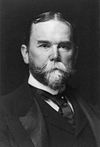 John Hay, class of 1858, was private secretary to Abraham Lincoln, man of letters, Ambassador to the Court of St. James's, and influential Secretary of State under Presidents McKinley and Theodore Roosevelt
John Hay, class of 1858, was private secretary to Abraham Lincoln, man of letters, Ambassador to the Court of St. James's, and influential Secretary of State under Presidents McKinley and Theodore Roosevelt
Brown University's alumni include numerous politicians, prominent academics, authors, journalists, activists, businessmen, computer science pioneers, media company heads, stage and film actors, and royalty. Its prominent alumni include Chief Justice of the U.S. Supreme Court and Secretary of State Charles Evans Hughes (1881), father of American public school education Horace Mann (1819), philanthropist John D. Rockefeller Jr. (1897), Secretary of State John Hay (1852), philosopher, civil libertarian, and Amherst College president Alexander Meiklejohn, first president of the University of South Carolina Jonathan Maxcy (1787), Bates College founder Oren B. Cheney (1836), longest-serving University of Michigan president (1871–1909) James Burrill Angell (1849), notable University of California president (1899–1919) Benjamin Ide Wheeler (1875), Morehouse College's first African-American president John Hope (1894), magazine editor John F. Kennedy, Jr. '83, diplomat Richard Holbrooke '62, founder of The Gratitude Network and The Intersection event Randy Haykin '85, legendary IBM chairman and CEO Thomas J. Watson, Jr. '37, CNN founder and America's Cup yachtsman Ted Turner '60, McKinsey & Co. co-founder and father of modern management consulting Marvin Bower '25, Bank of America chairman and CEO Brian Moynihan '81, Group of Thirty member and Citibank chairman William R. Rhodes '57, Chase Bank chairman and CEO Willard C. Butcher '48, Tiffany & Co CEO Walter Hoving '20, Motorola and Eastman Kodak chairman and CEO George M. C. Fisher (ScM '64, PhD '66), NASDAQ first president and CEO Gordon Macklin '50, Quadrangle Group founder and Treasury Department "Car Czar" for auto industry reorganization Steven Rattner '74, Apple Macintosh and Mac OS designer Andy Hertzfeld '75, architect of Intel 386, 486, and Pentium microprocessors John H. Crawford '75, Apple Computer CEO (1983–1993) John Sculley '61, NASA head during first seven Apollo missions Thomas O. Paine '42, chief scientist NASA Mars and lunar programs James B. Garvin '78, National Security Council director of counter-terrorism RP Eddy '94, inventor of the first silicon transistor Gordon Kidd Teal '31, former Securities and Exchange Commissioner, Annette Nazareth '78, Rockefeller Center and Tribune Tower architect Raymond Hood (1902).
 John D. Rockefeller, Jr., class of 1897, philanthropist who gave away half a billion dollars during his life
John D. Rockefeller, Jr., class of 1897, philanthropist who gave away half a billion dollars during his life
Alumni in the arts and media include actress Laura Linney '86, actor John Krasinski, composer Rusty Magee, '01, singer-composer Mary Chapin Carpenter '81, musicians Damian Kulash '98 and Dhani Harrison '02, composer Duncan Sheik '92, singer Lisa Loeb '90, New Yorker humorist and Marx Brothers screenwriter S.J. Perelman '25, novelists Nathanael West '24, Jeffrey Eugenides '83, Rick Moody '83, Edwidge Danticat (MFA '93), and Marilynne Robinson '66, playwrights Sarah Ruhl '97, Lynn Nottage '86, Richard Foreman '59, Alfred Uhry '58, and Nilo Cruz (MFA '94), Pulitzer Prize-winning investigative reporter and author James Risen '77, film directors Todd Haynes '85, Doug Liman '88, and Davis Guggenheim '86, and director-actor Tim Blake Nelson '86, 20th Century Fox Film Group president Tom Rothman '76, Black Entertainment Television chairman and CEO Debra L. Lee '76, HBO Sports president Ross Greenburg '77, MTV Films and Nick Movies president Scott Aversano '91, CNN US News Operations president Jonathan Klein '80, and Bravo TV president Lauren Zalaznick '84. English actress Emma Watson, best known for her role as Hermione Granger in the Harry Potter films, is a member of the class of 2013. Other notable alumni include Pro Football Hall of Fame sportscaster Chris Berman '77, Penn State football coach Joe Paterno '50, Heisman Trophy namesake John W. Heisman '91, Pollard Award namesake and first black All-American and NFL head coach Fritz Pollard '19.
Notable prominent academics include Dartmouth College president Jim Yong Kim '82, Nobel Laureates Craig Mello '82 and Jerry White '87, Cooley-Tukey FFT algorithm co-originator John Wilder Tukey '36, Gurney Professor of History and Political Science at Harvard Adam Ulam '44, physicist Lewis E. Little '62, Lasker Award winning biologist and founder of microbial pathogenesis Stanley Falkow (PhD '59), MIT computer science department chair John Guttag '71, MIT neuroscience department chair Mark F.Bear (B.A. '78, Ph.D '84), Penn psychologist, Lasker Award winner and cognitive therapy originator Aaron Beck '50, John Bates Clark Medal winning MIT economist Jerry A. Hausman '68, University of Chicago School of Law dean Daniel Fischel, and Chicago Booth economist Randall Kroszner '84.
Current governors include Governor of Louisiana Bobby Jindal '91, Delaware Jack Markell '82, and Rhode Island Lincoln Chafee '75.
As of 2010, Brown counts a total of 689 tenured faculty members. According to The Brown Daily Herald, in the 1980s there were only approximately 450 tenured faculty members at Brown. However, given its size, the Brown faculty has always been a small but elite group of world class researchers. Notable past or current faculty have included Nobel Laureates Lars Onsager, George Stigler, Vernon L. Smith, George Snell and Leon Cooper, Fields Medal winning mathematician David Mumford, mathematician Ulf Grenander, Pulitzer Prize winning historian Gordon S. Wood, Sakurai Prize winning physicist Gerald Guralnik for co-elucidation of the Higgs mechanism, award-winning physicist John M. Kosterlitz of the Kosterlitz-Thouless transition, computer scientist and inventor of hypertext Andries van Dam, computer scientist Robert Sedgewick, prominent engineers Daniel C. Drucker, L. Ben Freund, and Mayo D. Hersey, BrainGate inventor John Donoghue (Ph.D 79'), neuroscientist Mark F.Bear (B.A '78, Ph.D '82), biologist and prominent advocate of biological evolution Kenneth R. Miller, first president of the American Sociological Association Lester Frank Ward, economists Hyman Minsky, Peter MacAvoy, who was a former member of the US Council of Economic Advisers, William Poole (economist), Ross Levine, Oded Galor and Peter Howitt (economist), former Prime Minister of Italy and former EU chief Romano Prodi, former President of Brazil Fernando Cardoso, former President of Chile Ricardo Lagos, writers Carlos Fuentes, Chinua Achebe, Robert Coover, and Keith Waldrop, former Presidents of the American Philosophical Association Jaegwon Kim and Ernest Sosa, philosophers Curt Ducasse, Roderick Chisholm, and Martha Nussbaum, linguist Hans Kurath, and political scientist James Morone.
See also
- List of Brown University buildings
- List of Brown University statues
- Watson Institute for International Studies
- Brown Stadium
- Ladd Observatory
- Sarah Doyle Center
References
- ^ Brown University Admission Facts and Figures, Brown University website. Retrieved 28 December 2009.
- ^ "Endowment jumps to $2.5 billion in year of high returns'". http://www.browndailyherald.com/endowment-jumps-to-2-5-billion-in-year-of-high-returns-1.2656840#.TsBPCMIhFaq.
- ^ "Faculty and Employees". http://www.brown.edu/about/facts/faculty-and-employees.
- ^ a b c "Facts about Brown University". Brown University. http://www.brown.edu/web/about/facts/enrollment. Retrieved 26 January 2011.
- ^ "Encyclopedia Brunoniana | Bicentennial celebration". Brown University. http://www.brown.edu/Administration/News_Bureau/Databases/Encyclopedia/search.php?serial=B0180. Retrieved 9 July 2009.
- ^ "Get to Know Us: Our History". Brown University Admission Office. http://www.brown.edu/Administration/Admission/gettoknowus/ourhistory.html.
- ^ a b http://www.brown.edu/Administration/Institutional_Research/documents/QuickReference09-10.pdf
- ^ "Encyclopedia Brunoniana; Campus". Brown University. http://www.brown.edu/Administration/News_Bureau/Databases/Encyclopedia/search.php?serial=C0060. Retrieved 21 May 2010.
- ^ Mitchell, Martha. (1993). "Bear." Encyclopedia Brunoniana
- ^ "Education for Everybody: Brown's Innovation and Influence in Collegiate Education". Brown.edu. http://www.brown.edu/Facilities/University_Library/exhibits/education/founding.html. Retrieved 2011-10-05.
- ^ http://www.brown.edu/Administration/Corporation/downloads/charter-of-brown-university.pdf
- ^ "Baptist Identity and Christian Higher Education" (PDF). Baptist Identity and Christian Higher Education. Baylor University. http://www.baylor.edu/baylorpress/excerpt/105-excerpt.pdf. Retrieved 30 April 2010.
- ^ Brunson, Walter C. (1972). The History of Brown University, 1764–1914. p. 500.
- ^ "Providence." Encyclopædia Britannica. 1911. 11th edition. Vol 22 (POL-RHE). p. 511c: (Makeup of board, 22 Baptists, etc. No religious tests for admission. "Considered extraordinary liberal.")
- ^ "Brown University Commencement: History". Brown.edu. http://www.brown.edu/web/commencement/2010/content/history.html. Retrieved 2011-10-05.
- ^ Howell, Ricardo (July 2001). "Slavery, the Brown Family of Providence and Brown University". Brown University News Service. Archived from the original on 9 April 2008. http://web.archive.org/web/20080409001105/http://www.brown.edu/Administration/News_Bureau/Info/Slavery.html.
- ^ "Brown to Commemorate 225th Anniversary of the March to Yorktown". Brown University Office of Media Relations. 30 May 2006. http://www.brown.edu/Administration/News_Bureau/2005-06/05-137.html.
- ^ "General James Mitchell Varnum House Armory History". Varnum Continentals. http://www.varnumcontinentals.org/about.htm. Retrieved 8 August 2010.
- ^ "Proposed Amendments to the Articles of Confederation". Teachingamericanhistory.org. 1980-01-01. http://teachingamericanhistory.org/library/index.asp?document=1587. Retrieved 2011-10-05.
- ^ "History of Brown". About Brown. Brown University. http://www.brown.edu/web/about/history. Retrieved 5 December 2007.
- ^ "Draft of a working paper for education at Brown University by Ira Magaziner with Elliot Maxwell and others". Brown University Library. http://library.brown.edu/record=b2103786. Retrieved 6 December 2007.[dead link]
- ^ a b Leubsdorf, Ben (2 March 2005). "The New Curriculum Then". Brown Daily Herald. http://media.www.browndailyherald.com/media/storage/paper472/news/2005/03/02/Focus/The-New.Curriculum.Then-882258.shtml. Retrieved 5 December 2007.
- ^ Mitchell, Martha (1993). "Curriculum". Encyclopedia Brunoniana. Providence, Rhode Island: Brown University Library. ASIN B0006P9F3C. http://www.brown.edu/Administration/News_Bureau/Databases/Encyclopedia/search.php?serial=C0780. Retrieved 6 December 2007.
- ^ "RISD Grad Book 06-07" (PDF). Rhode Island School of Design. http://intranet.risd.edu/pdfs/GradHandbook0607.pdf. Retrieved 5 December 2007.
- ^ "about safeRIDE". safeRide for Brown + RISD. Brown University. http://www.brown.edu/saferide/. Retrieved 5 December 2007.
- ^ "Brown and RISD Announce Dual Degree Program" (Press release). Brown University. 24 July 2007. http://www.brown.edu/Administration/News_Bureau/2007-08/07-013.html. Retrieved 6 December 2007.
- ^ "Grade Inflation and the Brown Grading System: 2001–2002 Sheridan Center Research Project". The Teaching Exchange. Sheridan Center for Teaching, Brown University. Archived from the original on 12 June 2008. http://web.archive.org/web/20080612041616/http://www.brown.edu/Administration/Sheridan_Center/pubs/teachingExchange/jan2002/grade_inflat.shtml. Retrieved 5 December 2007.
- ^ Magaziner, Ira; Elliot Maxwell (15 March 2006). "Two Brown alums and architects of the New Curriculum express their skepticism toward plus/minus grading". Brown Daily Herald. http://media.www.browndailyherald.com/media/storage/paper472/news/2006/03/15/Columns/Ira-Magaziner.69.And.Elliot.Maxwell.68.Plusminus.System.Lacks.Educational.Value-1686938.shtml. Retrieved 5 December 2007.
- ^ Lutts, Chloe (15 March 2006). "Plus/minus fails key test: Faculty could still vote to change grading system". Brown Daily Herald. http://media.www.browndailyherald.com/media/storage/paper472/news/2006/03/15/CampusNews/Plusminus.Fails.Key.Test-1686967.shtml. Retrieved 11 December 2005.
- ^ "Plan for Academic Enrichment Status Report May 2007" (PDF). Brown University Office of the President. May 2007. http://www.brown.edu/web/pae/documents/PAEStatusReportMay2007_000.pdf. Retrieved 5 December 2007.
- ^ "Taskforce on Undergraduate Education". Brown University Office of the Provost. http://www.brown.edu/Administration/Provost/committees/tue/. Retrieved 5 December 2007.
- ^ Liss, Emmy (27 November 2007). "Brown loves Ruth: Approval rating for Simmons sky-high". Brown Daily Herald. http://media.www.browndailyherald.com/media/storage/paper472/news/2007/11/27/CampusNews/Brown.Loves.Ruth.Approval.Rating.For.Simmons.SkyHigh-3116895.shtml. Retrieved 5 December 2007.
- ^ "Ruth Simmons Resigning". Huffington Post. http://www.huffingtonpost.com/2011/09/15/ruth-simmons-resigning-brown_n_964174.html. Retrieved 9 September 2011.
- ^ Undergraduate Concentrations Completed: Selected Years
- ^ Brown University Office of Admission facts and figures
- ^ a b c http://www.brown.edu/Administration/Institutional_Research/documents/UndergraduateOutcomes2008.pdf
- ^ History of the Brown Medical School
- ^ "Best Medical Schools – Graduate Schools – Education – US News and World Report". Grad-schools.usnews.rankingsandreviews.com. http://grad-schools.usnews.rankingsandreviews.com/grad/med. Retrieved 9 July 2009.
- ^ La Bastille: A Tech House Art Installation
- ^ "Play Tetris On A Building Wall...And Steve Wozniak Will Visit You". The Mac Observer. 25 April 2000. http://www.macobserver.com/news/00/april/000425/wozontetris.shtml.
- ^ "America's Best Colleges". Forbes. 2011. http://www.forbes.com/top-colleges/list/. Retrieved October 6, 2011.
- ^ "National Universities Rankings". America's Best Colleges 2012. U.S. News & World Report. September 13, 2011. http://colleges.usnews.rankingsandreviews.com/best-colleges. Retrieved September 25, 2011.
- ^ "The Washington Monthly National University Rankings". The Washington Monthly. 2011. http://www.washingtonmonthly.com/college_guide/rankings_2011/national_university_rank.php. Retrieved August 30, 2011.
- ^ "Academic Ranking of World Universities: Global". Institute of Higher Education, Shanghai Jiao Tong University. 2011. http://www.shanghairanking.com/ARWU2011.html. Retrieved August 30, 2011.
- ^ "QS World University Rankings". QS Quacquarelli Symonds Limited. 2011. http://www.topuniversities.com/university-rankings/world-university-rankings/2011. Retrieved September 30, 2011.
- ^ "Top 400 - The Times Higher Education World University Rankings 2011-2012". The Times Higher Education. 2011. http://www.timeshighereducation.co.uk/world-university-rankings/2011-2012/top-400.html. Retrieved October 6, 2011.
- ^ "Brown holds steady at No. 15 in annual U.S. News rankings". The Brown Daily Herald. http://www.browndailyherald.com/campus-news/brown-holds-steady-at-no-15-in-annual-u-s-news-rankings-1.1676814. Retrieved 2011-10-05.
- ^ "A Focus on Undergrads" and "Best National Universities", U.S. News & World Report: America's Best Colleges: 2010 Edition, pp. 15, 88–9.
- ^ http://colleges.usnews.rankingsandreviews.com/best-colleges/national-counselor-rank; http://www.usnews.com/articles/education/best-colleges/2009/08/19/methodology-college-picks-by-high-school-counselors.html
- ^ "Top 200 - The Times Higher Education World University Rankings 2010-2011". Timeshighereducation.co.uk. http://www.timeshighereducation.co.uk/world-university-rankings/2010-2011/top-200.html. Retrieved 2011-10-05.
- ^ "QS World University Rankings". Topuniversities. http://www.topuniversities.com/university-rankings/world-university-rankings/2011. Retrieved 2011-10-05.
- ^ http://citeseerx.ist.psu.edu/viewdoc/download?doi=10.1.1.126.3066&rep=rep1&type=pdf
- ^ "SSRN-A Revealed Preference Ranking of U.S. Colleges and Universities by Christopher Avery, Mark Glickman, Caroline Hoxby, Andrew Metrick". Papers.ssrn.com. http://papers.ssrn.com/sol3/papers.cfm?abstract_id=601105. Retrieved 22 February 2010.
- ^ How to Choose a College – Forbes.com
- ^ "Best Colleges Press Release". Princetonreview.com. 2 August 2010. http://www.princetonreview.com/best-press-release.aspx. Retrieved 8 August 2010.
- ^ "Table: Top Producers of U.S. Fulbright Students by Type of Institution, 2010-11". The Chronicle of Higher Education. 2010-10-24. http://chronicle.com/article/Table-Top-Producers-of-US/125073. Retrieved 2011-10-05.
- ^ "Applied Math – Math – Graduate Schools – Education – US News and World Report". Grad-schools.usnews.rankingsandreviews.com. 15 April 2010. http://grad-schools.usnews.rankingsandreviews.com/best-graduate-schools/top-mathematics-programs/applied-mathematics. Retrieved 8 August 2010.
- ^ "Development Economics – Economics – Graduate Schools – Education – US News and World Report". Grad-schools.usnews.rankingsandreviews.com. 15 April 2010. http://grad-schools.usnews.rankingsandreviews.com/best-graduate-schools/top-economics-schools/development-economics. Retrieved 8 August 2010.
- ^ "Rankings – History – Graduate Schools – Education – US News and World Report". Grad-schools.usnews.rankingsandreviews.com. 15 April 2010. http://grad-schools.usnews.rankingsandreviews.com/best-graduate-schools/top-history-schools/rankings. Retrieved 8 August 2010.
- ^ "Rankings – Economics – Graduate Schools – Education – US News and World Report". Grad-schools.usnews.rankingsandreviews.com. 15 April 2010. http://grad-schools.usnews.rankingsandreviews.com/best-graduate-schools/top-economics-schools/rankings. Retrieved 8 August 2010.
- ^ "Rankings – English – Graduate Schools – Education – US News and World Report". Grad-schools.usnews.rankingsandreviews.com. 15 April 2010. http://grad-schools.usnews.rankingsandreviews.com/best-graduate-schools/top-english-schools/rankings. Retrieved 8 August 2010.
- ^ a b "Rankings – Math – Graduate Schools – Education – US News and World Report". Grad-schools.usnews.rankingsandreviews.com. 15 April 2010. http://grad-schools.usnews.rankingsandreviews.com/best-graduate-schools/top-mathematics-programs/rankings. Retrieved 8 August 2010.
- ^ (2011-03-30). "Brown admits 2,692 for Class of 2015 |". Brown University. http://news.brown.edu/pressreleases/2011/03/2015. Retrieved 2011-10-05.
- ^ "Facts about Brown University: Undergraduate Admission". Brown.edu. http://www.brown.edu/web/about/facts/admission. Retrieved 22 February 2010.
- ^ "August 2008 Update from the Dean". Brown University Graduate School. 31 March 2009. http://gradschool.brown.edu/update.php?id=1217563200.
- ^ "Brown admits 10.8% in most selective year ever". The Brown Daily Herald. 4 April 2006. http://media.www.browndailyherald.com/media/storage/paper472/news/2009/03/31/CampusNews/Brown.Admits.10.8.In.Most.Selective.Year.Ever-3689313.shtml?sourcedomain=www.browndailyherald.com&MIIHost=media.collegepublisher.com.
- ^ Ivy Success article
- ^ Hernandez College Consulting
- ^ Brown Ends Tuition for Lower-Income Students The New York Times February 25, 2008 . Retrieved February 25, 2008.
- ^ Brown Q&A 10/2009
- ^ a b R.M. Kliment & Frances Halsband Architects (January 2004). "Analysis". Strategic Framework for Physical Planning Brown University. Brown University. http://www.brown.edu/webmaster/strategic_framework/framework/kh.swf. Retrieved 21 December 2007.
- ^ "Brown Houses". Brown University. http://www.brown.edu/Facilities/Facilities_Management/docs/Brown%20Houses_11x17.jpg. Retrieved 21 December 2007.
- ^ From Martha Mitchell's Encyclopedia Brunoniana: John Hay Library
- ^ Drake, Miriam (2003). Encyclopedia of Library and Information Science. CRC Press. ISBN 0824720776. http://books.google.com/?id=tPnkxsklgXoC&dq=john+hay+library+librarians. Retrieved 1 April 2008.
- ^ "The Anne S. K. Brown Military Collection :: Brown University Library". Dl.lib.brown.edu. http://dl.lib.brown.edu/libweb/collections/askb/. Retrieved 22 February 2010.
- ^ Johnson, M.L. (2006, January 7). "Some of nation's best libraries have books bound in human skin." Associated Press
- ^ "Department of Facilities Management, Energy and Environmental Advisory Committee". Brown University. http://www.brown.edu/Facilities/Facilities_Management/energy_policy_recommendations.php. Retrieved 28 May 2008.
- ^ "information on Brown's efforts to create a more sustainable environment". Brown University. http://www.brown.edu/Departments/Brown_Is_Green/. Retrieved 28 May 2008.
- ^ "College Sustainability Report Card 2009". Sustainable Endowments Institute. http://www.endowmentinstitute.org/. Retrieved 28 October 2008.
- ^ "Brown emPower". Brown University. http://www.empowerbrown.org/blog/. Retrieved 11 June 2010.
- ^ Boldly Brown web site
- ^ "Top 10 Colleges with the Happiest Students – MSN Encarta". Archived from the original on 31 October 2009. http://www.webcitation.org/5kwQQEjvD.
- ^ Perkins, Sara. (2004, April 19). "Fashion Journal likes what Brown is wearing." The Brown Daily Herald
- ^ U.S. News & World Report. (2002, March 18). "College Sports: Honor Roll." U.S. News & World Report
- ^ "Brown GSC". Brown.edu. http://www.brown.edu/Students/GSC/. Retrieved 22 February 2010.
- ^ Cochrane Bronson, Walter (1972). The History of Brown University, 1764–1914. p. 500.
- ^ Meacham, Scott (1999). "Halls, Tombs and Houses: Student Society Architecture at Dartmouth". Dartmo.: The Buildings of Dartmouth College. http://www.dartmo.com/halls/hallscontent2.html. Retrieved 6 December 2007.
- ^ Mitchell, Martha (1993). "Philermenian Society". Encyclopedia Brunoniana. Providence, Rhode Island: Brown University Library. ASIN B0006P9F3C. http://www.brown.edu/Administration/News_Bureau/Databases/Encyclopedia/search.php?serial=P0190. Retrieved 6 December 2007.
- ^ Mitchell, Martha (1993). "United Brothers Society". Encyclopedia Brunoniana. Providence, Rhode Island: Brown University Library. ASIN B0006P9F3C. http://www.brown.edu/Administration/News_Bureau/Databases/Encyclopedia/search.php?serial=U0010. Retrieved 6 December 2007.
- ^ Mitchell, Martha (1993). "Franklin Society". Encyclopedia Brunoniana. Providence, Rhode Island: Brown University Library. ASIN B0006P9F3C. http://www.brown.edu/Administration/News_Bureau/Databases/Encyclopedia/search.php?serial=F0260. Retrieved 6 December 2007.
- ^ Mitchell, Martha (1993). "Fraternities". Encyclopedia Brunoniana. Providence, Rhode Island: Brown University Library. ASIN B0006P9F3C. http://www.brown.edu/Administration/News_Bureau/Databases/Encyclopedia/search.php?serial=F0270. Retrieved 6 December 2007.
- ^ "Societas Domi Pacificae 1824". Pacifica House. http://www.pacificahouse.org/. Retrieved 22 February 2010.
- ^ "Post- " Brown A-Z". Post.browndailyherald.com. 4 September 2009. http://post.browndailyherald.com/2009/09/04/brown-a-z/. Retrieved 22 February 2010.
- ^ Mitchell, Martha (1993). "Cammarian Club". Encyclopedia Brunoniana. Providence, Rhode Island: Brown University Library. ASIN B0006P9F3C. http://www.brown.edu/Administration/News_Bureau/Databases/Encyclopedia/search.php?serial=C0050. Retrieved 8 June 2009.
- ^ Poulson, Dan. (March 1, 2002). "Investigating the death of campus traditions." The Brown Daily Herald
- ^ Mitchell, Martha. (1993). "Van Wickle Gates." Encyclopedia Brunoniana
- ^ a b Mitchell, Martha. (1993). "Carberry, Josiah S.." Encyclopedia Brunoniana
- ^ "Brown Admission: Brown Traditions". http://www.brown.edu/Administration/Admission/gettoknowus/browntraditions.html.
- ^ Mitchell, Martha. (1993). "Spring Weekend." Encyclopedia Brunoniana
- ^ Brown Concert Agency
- ^ Mitchell, Martha. (1993). "Alma Mater." Encyclopedia Brunoniana
External links
Coordinates: 41°49′34″N 71°24′12″W / 41.826167°N 71.403250°W
Brown University Schools The College of Brown University • Brown University Graduate School • Alpert Medical School • School of EngineeringResearch Centers Pembroke Center for Teaching and Research on Women • Watson Institute for International Studies • Joukowsky Institute for Archaeology and the Ancient WorldAthletics Campus History Student Life Traditions • Alma Mater • Brown Daily Herald • Brown Journal of World Affairs • WBRU • Brown Student & Community Radio • Brown Television • The Brown JugOrganizations Brown Band • University Orchestra • Production Workshop • Opera Productions • The Chattertocks of Brown University • Badmaash Dance Company • Sarah Doyle Women's Center • University Mock TrialIvy League Articles Related to Rhode Island and The Providence Plantations
The Ocean State State of Rhode Island and Providence Plantations
State of Rhode Island and Providence PlantationsTopics Culture | Delegations | Geography | Government | History | Thirteen Colonies | Colonial Colleges | Images | Narragansett Indian Tribe | People | Visitor attractions | State symbols
Regions Counties: Bristol | Kent | Newport | Providence | Washington | Geographic: Blackstone Valley | Block Island
Cities Central Falls | Cranston | East Providence | Newport | Pawtucket | Providence | Warwick | Woonsocket
Towns Barrington | Bristol | Burrillville | Charlestown | Coventry | Cumberland | East Greenwich | Exeter | Foster | Glocester | Hopkinton | Jamestown | Johnston | Lincoln | Little Compton | Middletown | Narragansett | New Shoreham (Block Island) | North Kingstown | North Providence | North Smithfield | Portsmouth | Richmond | Scituate | Smithfield | South Kingstown | Tiverton | Warren | Westerly | West Greenwich | West Warwick
Categories:- Association of American Universities
- Brown University
- Educational institutions established in the 1760s
- 1764 establishments
- Ivy League
- Colonial Colleges
- Rhode Island in the American Revolution
- Non-profit organizations based in the United States
- National Association of Independent Colleges and Universities members
- New England Association of Schools and Colleges
- Universities and colleges in Rhode Island
- Universities and colleges in Providence, Rhode Island
- Georgian architecture
- Architectural styles
- Colonial architecture in the United States
Wikimedia Foundation. 2010.



